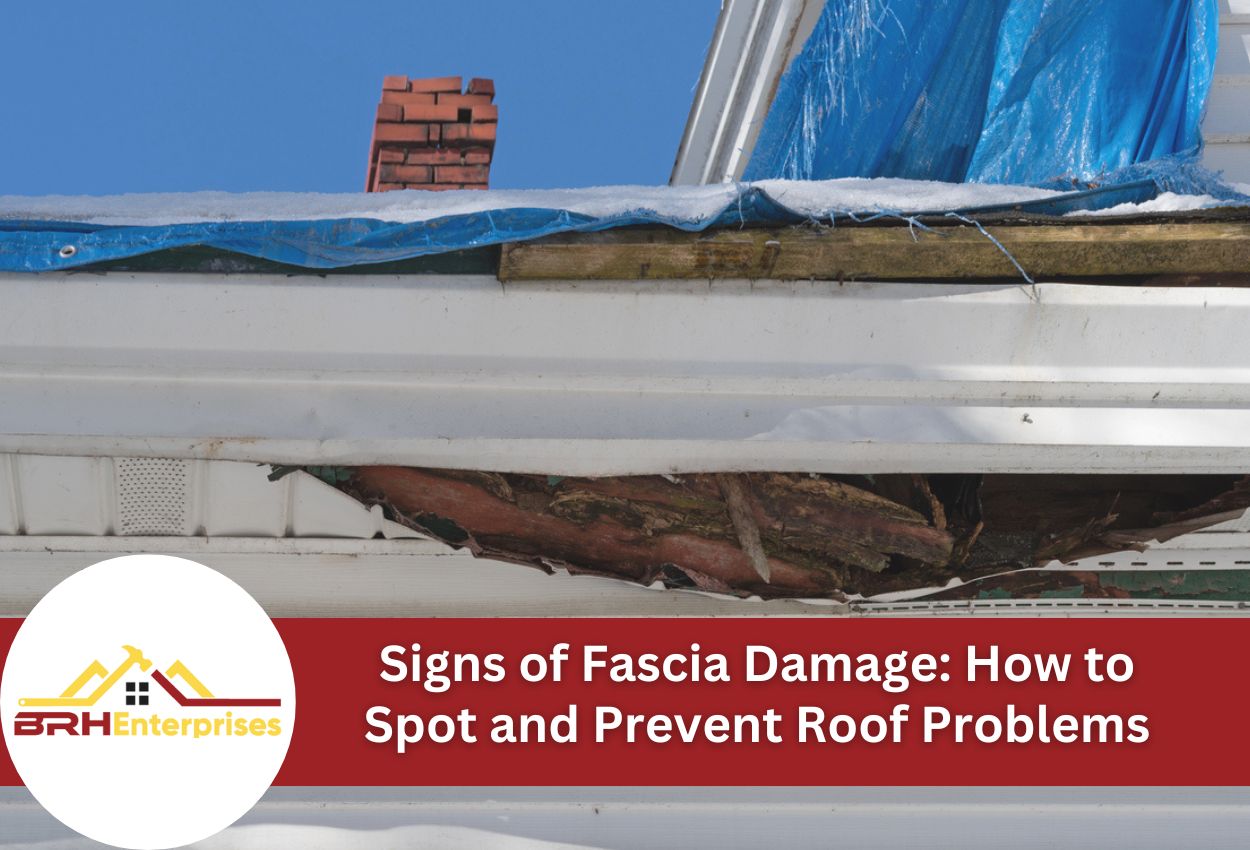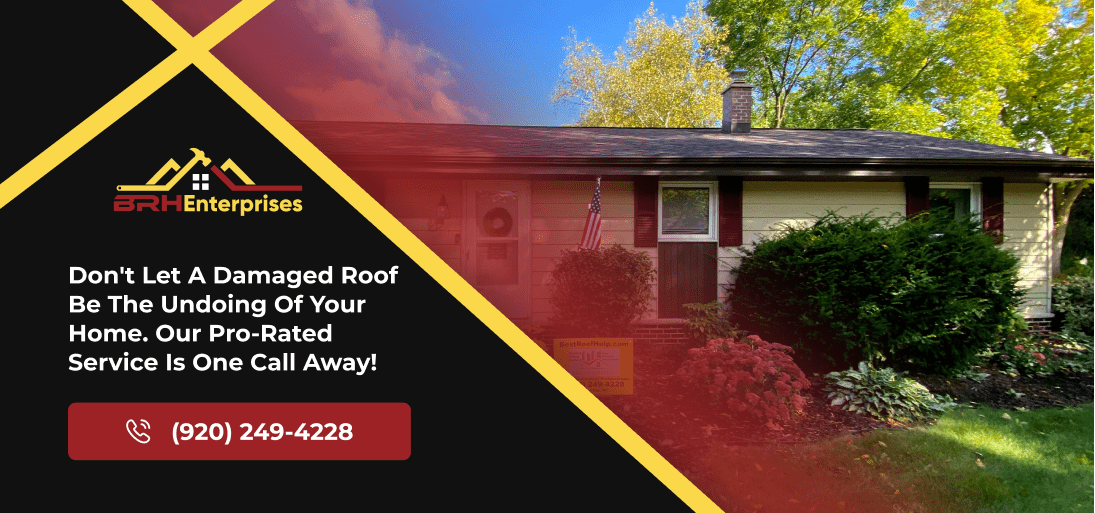Signs of Fascia Damage: How to Spot and Prevent Roof Problems
Estimated Reading Time : 6 Min.

Fascia boards are horizontal boards that run along the lower edge of your roof, creating a clean, finished appearance while protecting your home’s roofing structure. For homeowners in Southern Wisconsin, where seasonal weather changes can be harsh, maintaining your fascia is crucial for long-term roof health.
Located at the point where your rafter ends create the roof edge, fascia boards act as a barrier against moisture and pest intrusion. They provide a mounting surface for gutters and help seal the edge of your roof, preventing water from seeping into the roof deck and structural components. When fascia boards become damaged, they compromise this protective shield, potentially leading to significant structural issues.
Fascia works in conjunction with soffits (the undersides of roof overhangs) and gutters to form a complete defensive system for your home. This integrated roof overhang channels water away from your home while allowing proper attic ventilation. Recognizing roof fascia deterioration symptoms early can save homeowners substantial repair costs down the road and preserve the integrity of the entire roofing system.
Identifying compromised roof fascia requires knowing what warning signs to look for and understanding how these components function within your overall roof structure.
Visual Signs of Fascia Damage You Can Spot From the Ground
Keeping an eye on your fascia boards doesn’t always require scaling a ladder. Many damaged fascia board indications are visible from ground level, allowing homeowners to perform regular inspections safely.
Peeling or bubbling paint is often the earliest warning sign of fascia problems. This indicates moisture has penetrated the protective coating and is affecting the wood beneath. Discoloration, dark water stains, or greenish patches suggesting mold growth signal ongoing water damage. Watch for visible cracks, splits, or sections of fascia that appear to be pulling away from the roofline.
Southern Wisconsin homeowners should pay special attention to warping or sagging sections of fascia, which often result from our region’s freeze-thaw cycles. Visible rot or sections that are crumbling are advanced fascia rot warning signs requiring immediate professional attention.
To conduct a thorough ground inspection, walk completely around your home during the day. A pair of binoculars can provide a closer view of suspicious areas. Taking photos with a zoom lens can help document changes over time and provide reference points for soffit and fascia damage detection. Consider checking after heavy rain when water damage is most apparent.
Advanced Symptoms of Deteriorating Fascia Boards
When fascia damage progresses beyond the initial warning signs, more serious problems become evident. One telltale indication is sagging or detached gutters, which occur when the fascia boards they’re attached to have weakened. If you notice your gutters pulling away from the roofline or developing improper slopes, your fascia boards may be compromised.
Water stains appearing on exterior walls beneath the roofline strongly suggest that your fascia system is failing to direct water properly. These stains often appear brownish or yellowish and may expand over time. In severe cases, you might notice water damage extending to interior ceilings near exterior walls.
Advanced rot manifests as soft, crumbling wood that may break away when touched. This deterioration often spreads to neighboring roof components, compromising your entire roofing system. Wisconsin’s rain, snow, and humidity make our region particularly vulnerable to accelerated wood decay once water infiltration begins.
Wildlife activity around your fascia boards frequently signals existing damage. Birds, squirrels, and insects are drawn to softened wood for nesting opportunities. While occasional visitors aren’t cause for concern, repeated activity or visible nesting indicates animals have found entry points through damaged fascia. Look for creatures repeatedly visiting the same spot or debris falling from fascia areas. Wisconsin homeowners should specifically watch for carpenter bees drilling perfectly round holes in fascia boards, a distinct sign of infestation requiring professional intervention.
Weather-Related Fascia Damage Common in Southern Wisconsin
Southern Wisconsin’s climate creates perfect conditions for fascia damage. The region experiences extreme freeze-thaw cycles that cause fascia boards to expand and contract repeatedly, creating microscopic cracks that widen over time. When moisture penetrates these openings, the deterioration accelerates dramatically, leading to visible roof fascia deterioration symptoms within just a few seasons.
Heavy snow accumulation on roofs presents another challenge for Wisconsin homeowners. As snow melts and refreezes at roof edges, ice dams form behind gutters, forcing water beneath shingles and against fascia boards. This trapped moisture has nowhere to go except into the wood, causing fascia rot warning signs like discoloration and warping. The weight of ice-filled gutters can also pull away from weakened fascia, creating gaps where more moisture enters.
The dramatic temperature fluctuations common in our region, from below-zero winter days to humid 90-degree summers, stress fascia boards beyond their intended tolerances. To prevent ice dams, maintain sufficient attic insulation and ventilation to maintain consistent roof surface temperatures. Keeping gutters clean and aligned helps water flow away from fascia boards rather than backing up against them. Professional roofers can install specialized ice and water shield membranes along roof edges to provide additional protection against these weather-specific challenges that make identifying compromised roof fascia so important for Wisconsin homeowners.
Interior Warning Signs That Point to Fascia Problems
While exterior signs of fascia damage are most common, symptoms can also appear inside your home. Water stains on ceilings, particularly near exterior walls, often indicate that damaged fascia is allowing moisture into your home. These stains are typically yellow or brown rings and may grow larger after rainfall.
Mold growth in your attic is another serious indicator of fascia failure. When compromised fascia allows excess moisture into your attic space, it creates ideal conditions for mold development. This not only threatens your home’s structural integrity but can also impact indoor air quality and family health. Look for black, green, or white spots on attic surfaces during regular inspections.
Unexplained increases in energy bills often signal that fascia damage has compromised your home’s thermal envelope. When fascia boards deteriorate, they can create gaps that allow outdoor air to bypass insulation, forcing your heating and cooling systems to work harder. Southern Wisconsin homeowners should be more vigilant during summer and winter when these effects become most noticeable.
Conducting a thorough attic inspection can help identify fascia-related issues before they cause significant interior damage. Using a flashlight, check for water stains on rafters, damp insulation, or visible daylight around roof edges – all signs that your fascia may be failing. Addressing these warning signs promptly with professional roofing assistance can prevent expensive repairs and protect your home’s structural integrity.
Distinguishing Between Fascia and Soffit Damage
While fascia and soffit components work together to protect your home, they show different signs of damage that require specific identification techniques. Fascia boards, being directly exposed to the elements, typically show damage through visible rotting, paint peeling, and warping along the roofline. Soffits, located underneath the roof overhang, more commonly display water stains, sagging sections, or holes where pests have gained entry.
One key difference lies in how problems manifest: fascia damage often appears as horizontal deterioration along board sections, while soffit damage frequently shows as localized weak spots or ventilation blockages. When examining your home, remember that fascia boards bear the weight of gutters, making them susceptible to pulling away when damaged. Soffits, however, primarily show stress through discoloration or material breakdown where moisture has been trapped.
Wisconsin homeowners should understand that these systems are interconnected. Damaged fascia often leads to compromised soffits as water intrusion follows a predictable path. During inspections, use a systematic approach: first, examine the fascia for visible decay, then check if the connecting soffit shows corresponding damage in the same areas. Addressing both components simultaneously typically provides the most effective repair solution and prevents recurring issues that compromise your roof’s structural integrity.
When Fascia Damage is Beyond DIY Repair: Calling in the Pros
While minor fascia issues can sometimes be addressed by homeowners, most situations need a professional eye. Extensive rot that has penetrated beyond the surface layer of the fascia boards requires specialized assessment and repair techniques. If you notice your fascia has developed soft spots that yield to light pressure or appears crumbly when touched, the damage has likely progressed too far for DIY solutions.
Structural concerns are another clear indicator that professional intervention is needed. When fascia damage has allowed water to infiltrate supporting roof structures, including rafters or decking, the integrity of your entire roof system may be compromised. Signs include sagging rooflines, water stains on attic beams, or visible deterioration of structural elements.
During a professional fascia inspection, experienced Southern Wisconsin roofing contractors will assess not just the visible damage but also the underlying causes and potential hidden issues. They’ll examine the relationship between your fascia, soffit, and gutter systems to determine the full extent of necessary repairs. When meeting with contractors, ask about their history with similar repairs, their approach to preventing future damage, and what warranty they offer on replacement materials.
Before scheduled repairs, clear the area around your home’s perimeter to allow easy access to the roofline. Remove valuable or fragile items from areas beneath work zones, as fascia replacement may create vibrations that could affect interior walls or shelves.
Protect Your Home with Expert Fascia Repair Services from BRH Enterprises LLC
If you’ve noticed any of the signs of fascial damage mentioned above, it’s time to take immediate action to prevent further harm to your home. Peeling paint, visible cracks, and any signs of rot on your fascia boards are not just cosmetic issues — they can lead to serious structural damage if left unattended. Don’t wait for the problem to worsen. Call the professionals at BRH Enterprises LLC today to ensure your home remains safe and well-maintained.
At BRH Enterprises LLC, we specialize in identifying and repairing damaged fascia boards, keeping your roofing system robust and secure against Wisconsin’s harsh weather conditions. Our expert team is equipped to handle any level of damage, from minor fascia repairs to complete roofline replacements.
Contact us today at (920) 249-4228 to schedule a professional inspection and get your fascia issues resolved efficiently and effectively.


